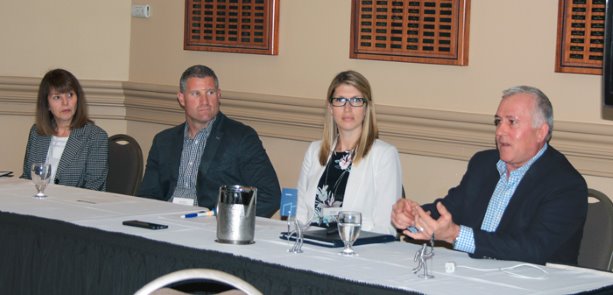While more and more contracts include a prequalification process for construction projects, many industry stakeholders have issues with how the process is conducted.
Prequalification and bid evaluation was the topic of a panel discussion at the recent PACE (Problem solving, Accountability, Collaboration and Execution) event hosted by the Grand Valley Construction Association in Waterloo, Ont.
The panel consisted of a consultant, an owner, a subcontractor and general contractor. Panellists included Pam Tolton, CET, vice-president and general manager of ABA Architects; Kathy Wyatt, manager of purchasing for the Town of Oakville; Wes Quickfall, president Conestogo Mechanical; and Jeff Shantz, vice-president, project development, Melloul Blamey Construction.
Quickfall said a trend that he is seeing is that some larger, complicated projects refer only to a CCDC 11 in the request for proposals (RFP). CCDC 11 is a document intended to provide information on the capacity, skill and experience of the contractor.
"Some smaller, less complicated projects are requesting significant qualification experience outside of the CCDC 11 and in some cases this is not necessary, where it should have been on the larger projects," he noted.
As a contractor, Shantz said he is seeing a move towards RFPs versus the lump sum approach. He noted RFPs often contain onerous clauses, demands and criteria that must be met or the contractor is disqualified. He said he would like to see a move towards more collaborative approaches such as Construction Management (CM) and Integrated Project Delivery (IPD).
"We definitely want to see more of that because working with the trades, we want to have the opportunity to have the best trades available working on our projects. The biggest challenge we can run into is poor trades performance," said Shantz.
"Poor trade performance always leads to litigation one way or another and having that opportunity to pick the best trades available to us eliminates a lot of that. When we’re doing the public bid, a lot of people don’t understand that we don’t have a choice. People say you have a choice. Well you do, if you don’t want to put in a bid that’s competitive."
Another challenge is poor leadership, he added.
"We prefer a better qualification process, better documents, better leadership and I think the biggest thing we’ve seen is poor leadership of the overall project," said Shantz. "We want to see better leadership of how the project is approached. With the consultants, we’re seeing the consultants’ liability, responsibility and risk being spread out and nobody in charge. We would like to see it going back to the architects being in charge so there is one source, which is what it used to be and at least there is more accountability within the consultant group. That equals better documents, equals better execution and, as far as we are concerned, less litigation."
In CM, ability to perform, financial liability of the company and track record of delivery are all factors, explained Shantz. Part of construction management involves working with a design team to create proper documents to prequalify trade contractors.
"Prequalification, to us, it means that we want to have people involved," said Shantz. "We want to have people that can finish and are not just there for a one-time project but have a good track record.
"In our case if you don’t deliver, it doesn’t do anybody or any institution any good. We all want success on the project."
In regards to the prequalification process, Quickfall spoke about the importance of following up with references, asking them to provide a detailed review of the previous project performance.
"An appendix A and B can illustrate significant accomplishments but without reference, information could be missing," said Quickfall referring to the CCDC 11 document. "Further to this, the prequalification reference check might involve projects not indicated on the prequalification. Industry and background ‘homework’ might be more diligent."
Tolton said her architectural firm sees more RFPs, especially with larger developers.
"For us definitely the shift is with the larger developers," she explained. "It’s the small jobs, I find, that are the small developers going out and doing the traditional bid documents…sometimes the not-for-profits."
Wyatt said the Town of Oakville has undertaken quite a few projects in the past few years that require RFPs as well.
"Our number one concern is how do we do this and make sure we’re being fair to all the proponents in the process and getting the right result," said Wyatt, adding the town is on its second IPD project and moving to IPD automatically switched the town to an RFP tender process.
"Oakville has stepped out of that comfort zone a little bit, taking the lead in this new direction. We’re learning as we go. We hired consultants to help us with the first process…This is something we are embracing."











Recent Comments
comments for this post are closed